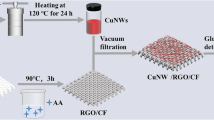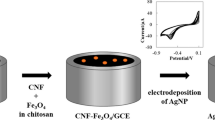Abstract
A non-enzymatic impedimetric glucose sensor was fabricated based on the adsorption of gold nanoparticles (GNPs) onto conductive polyaniline (PANI)-modified glassy carbon electrode (GCE). The modified electrode (GCE/PANI/GNPs) was characterized by using cyclic voltammetry (CV), electrochemical impedance spectroscopy (EIS), and scanning electron microscopy (SEM). The determination of glucose concentration was based on the measurement of EIS with the mediation of electron transfer by ferricyanide ([Fe(CN)6]3−). The [Fe(CN)6]3− is reduced to ferrocyanide ([Fe(CN)6]4−), which in turn is oxidized at GCE/PANI/GNPs. An increase in the glucose concentration results in an increase in the diffusion current density of the [Fe(CN)6]4− oxidation, which corresponds to a decrease in the faradaic charge transfer resistance (R ct). A wide linear concentration range from 0.3 to 10 mM with a lower detection limit of 0.1 mM for glucose was obtained. The proposed sensor shows high sensitivity, good reproducibility, and stability. In addition, the sensor exhibits no interference from common interfering substances such as ascorbic acid, acetaminophen, and uric acid.







Similar content being viewed by others
References
Mizutani F, Yabuki S (1997) Rapid determination of glucose and sucrose by an amperometric glucose-sensing electrode combined with an invertase/mutarotase-attached measuring cell. Biosens Bioelectron 12:1013–1020
Yoshimura K, Hozumi K (1996) Response characteristics of a glucose electrode with a sensing membrane prepared by plasma polymerization. Microchem J 53:404–412
Xu JJ, Chen HY (2000) Amperometric glucose sensor based on glucose oxidase immobilized in electrochemically generated poly(ethacridine). Anal Chem Acta 423:101–106
Liu L, Chen Y, Lv H, Wang G, Hu X, Wang C (2015) Construction of a non-enzymatic glucose sensor based on copper nanoparticles/poly(o-phenylenediamine) nanocomposites. J Solid State Electrochem 19:731–738
Gopalan AI, Lee KP, Ragupathy D, Lee SH, Lee JW (2009) An electrochemical glucose biosensor exploiting a polyaniline grafted multiwalled carbon nanotube/perfluorosulfonate ionomer-silica nanocomposite. Biomaterials 30:5999–6005
Ragupathy D, Gopalan AI, Lee KP (2009) Synergistic contributions of multiwall carbon nanotubes and gold nanoparticles in a chitosan–ionic liquid matrix towards improved performance for a glucose sensor. Electrochem Commun 11:397–401
Prakash S, Rao CRK, Vijayan M (2009) Polyaniline–polyelectrolyte–gold (0) ternary nanocomposites: synthesis and electrochemical properties. Electrochem Acta 54:5919–5927
Mazeiko V, Kausaite-Minkstimiene A, Ramanaviciene A, Balevicius Z, Ramanavicius A (2013) Gold nanoparticle and conducting polymer-polyaniline-based nanocomposites for glucose biosensor design. Sensors Actuators B 189:187–193
Xu Q, Gu SX, Jin L, Zhou Y, Yang Z, Wang W, Hu X (2014) Graphene/polyaniline/gold nanoparticles nanocomposite for the direct electron transfer of glucose oxidase and glucose biosensing. Sensors Actuators B 190:562–569
Suganandam K, Santhosh P, Sankarasubramanian M, Gopalan A, Vasudevan T, Lee KP (2005) Fe3+ion sensing characteristics of polydiphenylamine-electrochemical and spectroelectro-chemical analysis. Sensors Actuators B 105:223–231
Ojani R, Raoof JB, Zarei E (2010) Preparation of poly N,N-dimethylaniline/ferrocyanide film modified carbon paste electrode: application to electrocatalytic oxidation of 1-cysteine. J Electroanal Chem 638:241–245
Zhai D, Liu B, Shi Y, Pan L, Wang Y, Li W, Zhang R, Yu G (2013) Highly sensitive glucose sensor based on Pt nanoparticle/polyaniline hydrogel heterostructures. ACS Nano 7:3540–3546
Ahammad AJS, Sarker S, Lee JJ (2011) Immobilization of horseradish peroxidase onto a gold-nanoparticle-adsorbed poly (thionine) film for the construction of a hydrogen peroxide biosensor. J Nanosci Nanotechnol 11:5670–5675
Ahammad AJS, Shaikh AA, Jessy NJ, Akter T, Mamun AA, Bakshi PK (2015) Hydrogen peroxide biosensor based on the immobilization of horseradish peroxidase onto a gold nanoparticles-adsorbed poly (brilliant cresyl blue) film. J Electrochem Soc 162:B52–B56
Jena BK, Raj CR (2006) Enzyme-free amperometric sensing of glucose by using gold nanoparticles. Chem Eur J 12:2702–2708
Chowdhury AD, Gangopadhyay R, De A (2014) Highly sensitive electrochemical biosensor for glucose, DNA and protein using gold-polyaniline nanocomposites as a common matrix. Sensors Actuators B 190:348–356
Liu Y, Feng X, Shen J, Zhu JJ, Hou W (2008) Fabrication of a novel glucose biosensor based on a highly electroactive polystyrene/polyaniline/Au nanocomposite. J Phys Chem B 112:9237–9242
Zhang YC, Liu YX, Su L, Zhang ZH, Huo DQ, Hou CJ, Lei Y (2014) CuO nanowires based sensitive and selective non-enzymatic glucose detection. Sensors Actuators B 191:86–93
Heller A, Feldman B (2008) Electrochemical glucose sensors and their applications in diabetes management. Chem Rev 108:2482–2505
Prakash S, Shahi VK (2011) Enzyme free glucose sensor exploiting a poly (dimethylaniline) grafted sulfonated ionomer-copper nanocomposite. Anal Methods 3:1331–1337
Shervedani RK, Mehrjardi AH, Zamiri N (2006) A novel method for glucose determination based on electrochemical impedance spectroscopy using glucose oxidase self-assembled biosensor. Bioelectrochemistry 69:201–208
Česen A, Kosec T, Legat A (2013) Characterization of steel corrosion in mortar by various electrochemical and physical techniques. Corros Sci 75:47–57
Wagner N, Friedrich KA (2009) Application of electrochemical impedance spectroscopy for fuel cell characterization: PEFC and oxygen reduction reaction in alkaline solution. Fuel Cells 9:237–246
Inzelt G, Lang G (1994) Model dependence and reliability of the electrochemical quantities derived from the measured impedance spectra of polymer modified electrodes. J Electroanal Chem 378:39–49
Benavente J, Ramos-Barrado JR, Cabeza A (1996) Electrical behaviour of an inorganic film from AC and DC measurements. J Colloid Interface Sci 180:116–121
Protsailo LV, Fawcett WR (2000) Studies of electron transfer through self-assembled monolayers using impedance spectroscopy. Electrochem Acta 45:3497–3505
Ahammad AJS, Sarker S, Rahman MA, Lee JJ (2010) Simultaneous determination of hydroquinone and catechol at an activated glassy carbon electrode. Electroanalysis 22:694–700
Shaikh AA, Saha SK, Bakshi PK, Hussain A, Ahammad AJS (2013) Poly(brilliant cresyl blue)-modified electrode for highly sensitive and simultaneous determination of hydroquinone and catechol. J Electrochem Soc 160:B37–B42
Chowdhury TR, Shaikh AA, Akter H, Neaz MM, Bakshi PK, Ahammad AJS (2014) Highly sensitive detection of amoxicillin based on gold nanoparticle-modified ITO electrode. ECS Solid State Lett 3:P14–P16
Chang G, Shu H, Ji K, Oyama M, Liu X, He Y (2014) Gold nanoparticles directly modified glassy carbon electrode for non-enzymatic detection of glucose. Applied Surface Sci 288:524–529
Zane D, Appetecchi GB, Bianchini C, Passerini S, Curullia A (2011) An impedimetric glucose biosensor based on overoxidized polypyrrole thin film. Electroanalysis 23:1134–1141
Xiang C, Zou Y, Qiu S, Sun L, Xu F, Zhou H (2013) Bienzymatic glucose biosensor based on direct electrochemistry of cytochrome c on gold nanoparticles/polyaniline nanospheres composite. Talanta 110:96–100
MM G, BZ J, DI B, MG A, ZD K-J, BN G (2011) Electrochemical determination of glucose using polyaniline electrode modified by glucose oxidase. Food Chem 124:396–400
Zhang S, Wang N, Yu H, Niu Y, Sun C (2005) Covalent attachment of glucose oxidase to an Au electrode modified with gold nanoparticles for use as glucose biosensor. Bioelectrochemistry 67:15–22
Li C, Su Y, Lv X, Xia H, Shi H, Yang X, Zhang J, Wang Y (2012) Controllable anchoring of gold nanoparticles to polypyrrole nanofibers by hydrogen bonding and their application in nonenzymatic glucose sensors. Biosens Bioelectron 38:402–406
Çiftçi H, Tamer U (2012) Functional gold nanorod particles on conducting polymer poly(3-octylthiophene) as non-enzymatic glucose sensor. React Funct Polym 72:127–132
Zhanga H, Meng Z, Wang Q, Zheng J (2011) A novel glucose biosensor based on direct electrochemistry of glucose oxidase incorporated in biomediated gold nanoparticles–carbon nanotubes composite film. Sensors Actuators B 158:23–27
Haghighi B, Tabrizi MA (2013) Direct electron transfer from glucose oxidase immobilized on an overoxidized polypyrrole film decorated with Au nanoparticles. Colloids Surfaces B: Biointerfaces 103:566–571
Li J, Yuan R, Chai Y, Che X, Li W, Zhong X (2011) Nonenzymatic glucose sensor based on a glassy carbon electrode modified with chains of platinum hollow nanoparticles and porous gold nanoparticles in a chitosan membrane. Microchim Acta 172:163–169
Acknowledgments
This work was supported by The World Academy of Sciences (TWAS) Research Grant Program (Ref. 12–183 RG/CHE/AS_I and UNESCO FR 12–183 RG/CHE/AS_I). We thank Dr. Subrata Sarker at Hongik University for valuable discussion regarding electrochemical impedance spectroscopy.
Author information
Authors and Affiliations
Corresponding author
Rights and permissions
About this article
Cite this article
Ahammad, A.J.S., Al Mamun, A., Akter, T. et al. Enzyme-free impedimetric glucose sensor based on gold nanoparticles/polyaniline composite film. J Solid State Electrochem 20, 1933–1939 (2016). https://doi.org/10.1007/s10008-016-3199-2
Received:
Revised:
Accepted:
Published:
Issue Date:
DOI: https://doi.org/10.1007/s10008-016-3199-2




